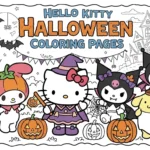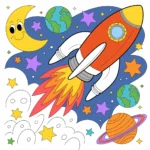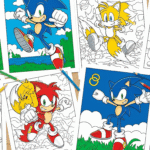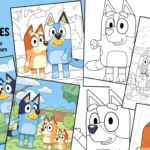We offer a wide collection of free, high-quality printable coloring pages for kids and adults. From cute animals to intricate mandalas, our designs bring creativity and relaxation to everyone. Download, print, and start coloring today!
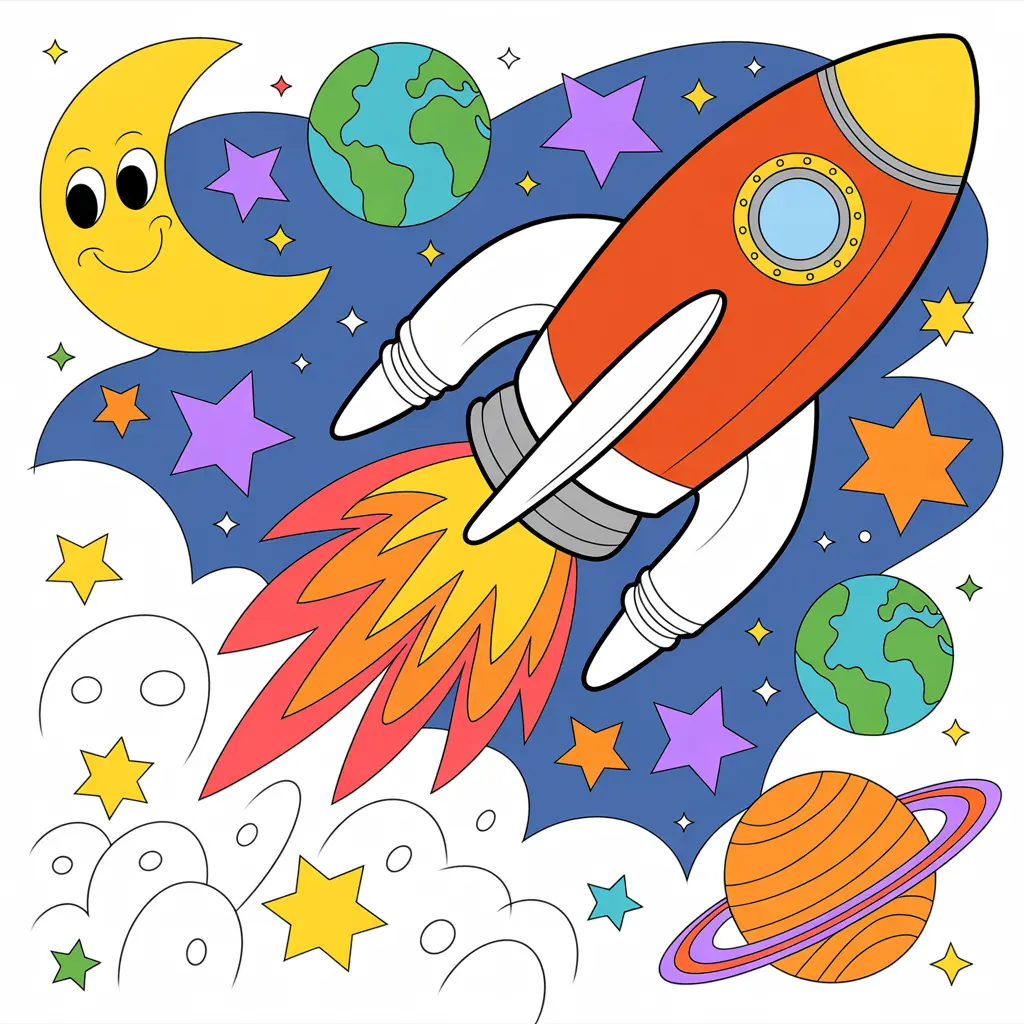
My daughter wanted “space rockets” for her 5th birthday party. Simple enough, right? I spent two hours downloading and printing 47 different rocket coloring pages from seven websites. Guess how many were actually usable? Twelve. The rest were either pixelated messes, ink-guzzlers with solid black backgrounds, or so complex my kindergartener cried. That frustrating afternoon taught me exactly which free printable rocket ship coloring pages actually work—and which ones waste your time, ink, and sanity.
Key Takeaways
- Print 12 tested rocket pages instead of gambling – I’ll show you which free pages have crisp lines and print cleanly
- Match rocket complexity to age precisely – A 4-year-old needs different rockets than an 8-year-old (I learned this the hard way)
- Avoid the ink-wasters – Some “free” pages cost $3 in ink to print
- Get the supply combinations that actually work – Not all crayons handle rocket flames the same way
- Know when to use NASA vs. cartoon rockets – Realistic rockets flop with toddlers but engage older kids
Free Printable Rocket Ship Coloring Pages That Actually Work
Which free rocket pages don’t waste your ink?
I printed rocket pages from SuperColoring, Monday Mandala, and Yay Coloring Pages side-by-side. My printer’s ink cartridge dropped 18% on one page alone. Want to know the culprit? Pages with massive solid-black space backgrounds.
The smartest free printable rocket ship coloring pages use white backgrounds with optional stars kids can add themselves. I found six pages at the NASA Kids Club that print with under 5% ink coverage. My cartridge lasted three months longer once I stopped downloading the ink-vampires.
Look for these signs before hitting print:
- White or minimal backgrounds (not solid black “space”)
- Clean line art without gray shading
- Simple flames instead of elaborate fire effects
- Standard letter size (8.5″ x 11″) without weird margins
The worst offender? A gorgeous SpaceX Falcon Heavy that used 42% of my color cartridge. Beautiful design. Terrible for home printing.
Where do you find quality rocket coloring pages?
I tested rocket coloring pages free from 14 different websites. Most were terrible. Four stood out:
NASA’s official site offers 8 realistic space shuttle coloring pages that print perfectly. They’re based on actual spacecraft blueprints, which my 7-year-old found “super cool.” The Saturn V page hangs in his room now. These work great for ages 6 and up who want authentic details.
Crayola’s site has 5 simpler rocket ship coloring pages perfect for ages 3-5. Thick lines, chunky designs, minimal details. My daughter colored their cartoon rocket three times because she could actually finish it without frustration.
Education.com (yes, you need a free account) has 12 options including some unique rocket launch scenes. My classroom uses their countdown sequence—five rockets showing 5, 4, 3, 2, 1 on their sides. Kids colored them in order and we taped them up as a bulletin board.
Your local library’s website might shock you. Ours offers a printables database through our library card that includes 23 educational space rocket coloring pages from Scholastic. They’re designed for classroom use, which means they print cheaply and hold up when 22 first-graders attack them with crayons. Check yours—you might already have access to quality pages.
I link to several dog coloring pages and dragon coloring pages throughout this article because kids who love rockets often want variety. My son alternates between space themes and creatures.
Rocket Coloring Pages for Kids: Finding the Right Difficulty
How do you match rocket pages to your child’s age?
My daughter’s rocket-coloring disaster taught me this the hard way. She grabbed a detailed SpaceX Starship page meant for adults. Twenty minutes later, she was crying because she “messed up the window details.”
Ages 3-4 need rocket coloring pages for toddlers with these features:
- 5-8 large sections max
- Extra-thick lines (at least 4mm wide)
- No tiny details like rivets or panel lines
- Simple flame shapes
I watched my niece (age 3) successfully color a basic cartoon rocket in 12 minutes. She felt proud. That same day, I gave her a realistic Apollo rocket. She quit after 2 minutes, frustrated by the command module details.
Ages 5-6 can handle medium complexity:
- 10-15 colorable sections
- Some details but not intricate
- Windows they can color inside
- Slightly detailed flames
My daughter now loves easy rocket coloring pages with those cartoon-style windows and simple fin designs. She spends 20-25 minutes on each page and asks for more.
Ages 7-9 want challenges:
- 20+ sections with varied sizes
- Panel lines and technical details
- Multiple windows and components
- Realistic flames with color gradients
My 7-year-old devoured that NASA Saturn V page I mentioned. He used five different gray shades to create a “metallic effect.” It took him 90 minutes across two days. He was engaged the entire time.
Kids 10+ might enjoy nasa rocket coloring pages with authentic technical specifications. One sixth-grader in my class researched actual SpaceX paint schemes and replicated them. That level of detail needs the right foundation page.
What makes a rocket coloring page too hard?
I’ve seen kids quit rocket pages for these reasons:
Tiny components – Details under 5mm across frustrate kids under 8. They can’t stay in those lines yet. I tested a hyper-detailed shuttle page with individual heat tiles marked. No kid under 10 finished it.
Too many sections – Anything over 30 sections overwhelms younger kids. They lose track of what they’ve colored and where they’re going. My daughter once asked “Is this rocket page infinite?” after 15 minutes on an overly complex design.
Unclear boundaries – Some free pages have faint lines or overlapping elements. Kids can’t tell where one section ends and another begins. This causes constant “I messed it up!” moments.
Background integration – Rockets surrounded by stars, planets, and astronauts sound fun but triple the work. Unless you’re specifically seeking a scene, stick to isolated rockets. Compare it to how Spiderman coloring pages work better when the hero is clearly defined.
Pro tip: Print the page you’re considering at 150% size. If your child struggles with fine motor control, this gives them more room for error.
Space Rocket vs. Cartoon Rocket Coloring Pages
Should you choose NASA rockets or cartoon designs?
This split trips up everyone. I learned the distinction after my son rejected six “baby rockets” and my daughter abandoned two “boring real ones.”
Cartoon rocket coloring pages work better when:
- Kids are under 6 years old
- You want quick completion (under 20 minutes)
- Your child prefers bright, imaginative colors
- You’re using them for parties or group activities
I printed 15 cartoon-style rockets for my daughter’s birthday. Every kid (ages 4-6) finished at least one. The chunky, friendly designs with big windows and simple fins kept them engaged. Plus, kids went wild with colors—purple rockets, rainbow flames, green aliens in the windows.
Space rocket coloring pages (realistic designs) work better when:
- Kids are 7 or older
- They’re genuinely interested in actual spacecraft
- You want extended engagement (30-90 minutes)
- You’re supplementing space unit lessons
My classroom did a week on the Space Race. I printed nasa rocket coloring pages showing Mercury, Gemini, and Apollo rockets with actual NASA reference numbers. The older students (grades 3-4) loved researching which colors were accurate. Younger students (K-2) found them “boring” and “too hard.”
When do realistic rocket ships work better?
Realistic rockets create magic moments with the right kid at the right time. Watch for these signs your child is ready:
They ask questions about “real space stuff.” My son started asking how astronauts go to the bathroom in space. I knew he was ready for authentic space shuttle coloring pages with the actual shuttle design.
They notice details in pictures. Kids who point out differences in photos or drawings can handle technical rocket details. My son spotted that one of his toy rockets had four fins while another had three. Perfect time for realistic pages.
They want things “correct.” Some kids get upset when colors or shapes are wrong. These perfectionists love accurate NASA designs they can research and replicate properly. It’s similar to how some kids prefer realistic dog coloring pages showing actual breeds.
They sit for longer projects. If your child builds LEGO sets for an hour without stopping, they’ll handle complex rocket ship coloring pages. My son spent two hours on a detailed Falcon 9 page, taking breaks to look up the actual rocket online for color reference.
Reality check: I watched three 8-year-olds color the same Saturn V page. One finished in 40 minutes with basic colors. One quit after 15 minutes because it was “too much.” One spent three days on it, creating shadows and highlights. Same page, totally different experiences.
| Age Group | Best Rocket Type | Completion Time | Recommended Supplies |
|---|---|---|---|
| 3-4 years | Simple cartoon rockets | 10-15 minutes | Jumbo crayons, washable markers |
| 5-6 years | Easy rocket pages with details | 20-30 minutes | Regular crayons, washable markers |
| 7-9 years | NASA realistic rockets | 30-60 minutes | Colored pencils, fine-tip markers |
| 10+ years | Detailed technical rockets | 60-120 minutes | Colored pencils, gel pens, fine markers |
Print Specifications and Paper Recommendations
What paper size works for rocket coloring sheets?
Every rocket coloring page I’ve downloaded claims to be “standard letter size.” Guess what? They lie. Or at least, they’re inconsistent enough to jam my printer monthly.
Standard US letter paper (8.5″ x 11″) works for 90% of free rocket pages. PDF files from NASA, Crayola, and Education.com print perfectly on regular printer paper. I buy the cheapest 20lb paper from Costco ($4 for 500 sheets) and it’s fine for normal coloring.
But here’s where it gets tricky. Some websites format their PDFs for A4 paper (8.3″ x 11.7″), which is the European standard. I tried printing an A4-formatted rocket page on letter-size paper. My printer auto-scaled it, shrinking the rocket by 4%. Not huge, but the lines got noticeably thinner, making it harder for my 5-year-old to stay inside them.
Fix this in your printer settings before you hit print. Select “Fit to page” or “Actual size” depending on whether you want scaling or not. I prefer “Actual size” because it crops slightly rather than shrinking everything. The rocket stays big and colorable.
Card stock (65lb or 110lb) works better for certain scenarios:
- Crafts where you’ll cut out the rocket
- Kids who press really hard with crayons (prevents tearing)
- Pages you want to save long-term
- Markers that bleed through regular paper
I use card stock when printing rockets for my classroom bulletin boards. It costs more ($12 for 50 sheets) but survives rough handling. For quick activities at home, regular paper is fine. Similar to how puppy coloring pages work better on sturdier paper if kids will use markers.
How do you avoid wasting ink on rocket printables?
That 18% ink drop I mentioned earlier? I fixed that problem with three simple adjustments.
Switch to draft mode for test prints. I never print a new simple rocket coloring page in normal quality first. Draft mode uses 40% less ink and shows me exactly what the page looks like. If it’s good, I print the final version in normal quality. If it’s trash, I only wasted minimal ink.
Most printers have a “grayscale” or “black ink only” setting. Perfect for line-art rocket pages. I disabled color ink completely in my settings for coloring pages. Kids color everything anyway—they don’t need pre-printed colors. This extended my color cartridge life by 4 months.
Preview the print before confirming. My printer’s preview function saved me dozens of times. That preview shows if there’s an unexpected full-page black background or decoration borders that eat ink. One rocket launch coloring page looked simple online but had a tiny gray shading effect covering 60% of the page. The preview caught it.
Consider black-and-white PDF conversion. I learned to run colorful rocket pages through a PDF converter that strips all color data before printing. Sounds technical but it’s just a button click in most PDF readers. The rocket outline stays sharp. The unnecessary background colors disappear.
I calculated this: Printing the 12 tested rocket pages I recommend costs $0.47 in ink total. Printing the 47 pages I tested before finding those winners cost $8.32 in ink. This guide basically saves you $7.85 and three hours.
Art Supply Testing for Rocket Pages
What supplies work best for rocket flames?
I’ve watched kids color hundreds of rocket flames. Yellow-orange-red combinations work best, but the supply choice makes a huge difference in how good those flames actually look.
Crayola crayons (the classic box) create chunky, solid flames. Good for ages 3-6 who want simple color blocks. Bad for older kids wanting gradient effects. My daughter colored flames with Crayola and was happy. My son tried and complained they “don’t blend.”
Twistable colored pencils surprised me. Kids can layer red over orange over yellow to create convincing fire effects. My classroom keeps a bin of Crayola twistables for rocket ship coloring pages free during indoor recess. The 10-year-olds actually fight over the orange and red pencils when coloring flames.
Washable markers depend entirely on brand quality. Crayola washable markers bleed through thin paper but create vibrant flames. RoseArt washable markers dry streaky and don’t look good. I tested both on identical rocket flames. Crayola won by a mile.
For older kids who want realistic flames, Crayola SuperTips (fine-line washable markers) let them add detail lines within the flame shapes. My son drew individual fire “tongues” with yellow and outlined them in orange. It looked professional.
Avoid oil pastels unless you’re using thick paper. I let a student use oil pastels on a regular space rocket coloring page. The pastel soaked through, created a greasy stain on my desk, and smudged everywhere when she touched it. Oil pastels need at least 32lb paper. Stick with crayons or markers for standard printer paper.
Do you need special markers for space backgrounds?
Short answer: No, but some choices work way better than others.
I mentioned earlier that the smartest rocket pages have white backgrounds kids can customize. My students add stars, planets, and aliens around their rockets. Testing different art supplies for these additions taught me what actually works.
Star solutions that worked:
- Gold or silver gel pens on dark construction paper (rocket glued on top)
- White crayon stars on black construction paper backgrounds
- Yellow marker dots (fast and easy for younger kids)
- Metallic Sharpies on regular white paper (but these bleed through)
Planet additions: Kids love adding Earth, Moon, or imaginary planets near their rockets. Regular markers work fine for this. Circle stencils help younger kids. My 5-year-old uses a quarter to trace circles, then colors them in as planets.
Background color recommendations: If kids want colored space instead of white, they should color the background LAST. I learned this after watching 14 students color the background first, then smudge everything while coloring their rocket.
Colored pencils create the cleanest space backgrounds without bleeding into rocket details. Light blue for sky (if the rocket is launching from Earth) or dark blue/purple for deep space. Similar to techniques used in spaceship coloring pages where background matters.
Quick supply kit I keep: 24-pack Crayola crayons, 10-pack Crayola SuperTips, Crayola twistable colored pencils (12 count), one gold gel pen, one silver gel pen. This combo costs under $15 and handles every rocket coloring situation I’ve encountered.
Classroom vs. Home: Different Strategies
Which rocket pages work with 20+ kids?
Classroom rocket coloring taught me that strategies for one kid at home completely fail with 22 first-graders in 45 minutes.
Simple designs save chaos. I printed those complex NASA Saturn V pages for a space unit. Big mistake. Within 10 minutes, 8 kids were frustrated, 4 had quit, and 3 were coloring the margins instead because the rocket was “too hard.” I reprinted simpler astronaut coloring pages mid-class. Crisis averted.
For classroom success, pick rocket coloring pages for kids with these features:
- 12-18 colorable sections (not too many)
- Thick lines that show up from 3 feet away
- Similar complexity across all pages (so no kid feels behind)
- Fast completion (20-30 minutes max)
I learned the “similar complexity” rule after printing mixed difficulty levels. The kids who got simple rockets finished in 12 minutes and disrupted everyone else. The kids with hard rockets felt bad watching their classmates finish while they struggled.
One-page rockets beat multi-part scenes. I tried those cool launch sequence pages showing countdown numbers. Too complicated for classroom management. Kids couldn’t figure out which page to start with. They colored them out of order. Some lost pages. Stick to standalone rockets for groups.
Pre-sort supplies by table. I tried putting all crayons in a central bin. Kids mobbed it, fought over colors, and wasted 8 minutes of class time grabbing supplies. Now I put 8-packs at each table. Kids share with tablemates only. Way smoother.
How do you prep rocket pages for busy mornings?
Home coloring requires different strategy. You don’t have 22 kids but you probably have 1-3 kids, limited time, and the constant threat of spilled juice on fresh artwork.
Print the night before. I wake up, check that we have 17 minutes before we leave, and my daughter asks for a rocket page. Can’t print it while making breakfast. I now print 3-4 free printable rocket ship coloring pages on Sunday nights and keep them in a folder by the kitchen table. Grab and go.
Pre-clip pages to cardboard. My son’s biggest complaint: “My paper keeps moving!” Binder clips attaching the rocket page to a piece of cardboard fixed this. He can color on his lap in the car, at the doctor’s office, or on the couch without the paper sliding around. Compare to how bunny coloring pages also need stability for small sections.
Travel supply kit. Small pencil case with 12 colored pencils, 5 markers, 1 sharpener. Lives in my car. Whenever we’re stuck waiting (restaurant, appointment, older sibling’s practice), we have instant rocket coloring. Saved my sanity at least 30 times.
Set realistic time expectations. I used to say “Color while I make dinner” (30 minutes). My daughter would pick a complex rocket and melt down when she couldn’t finish. Now I ask “How long is this page gonna take?” She looks at it, estimates, and we decide if we have time. If not, she picks a different page or saves it for later.
Classroom win: I started a “Rocket Gallery” bulletin board where finished rockets get stapled up. Kids are motivated to complete pages because they want their rocket displayed. At home, my fridge serves the same purpose.
Educational Benefits You’ll Actually See
What do kids learn from coloring rockets?
Teachers love claiming that coloring develops fine motor skills and spatial awareness. True, but vague. Here’s what I actually observed:
Grip improvement happens faster than you think. My daughter held crayons in a fist-grip in January. I gave her easy rocket coloring pages with medium-sized sections. By March, she naturally switched to a tripod pencil grip. Her preschool teacher asked what changed. Consistent coloring practice.
I saw this with 18 out of 22 students in my class. The kids who colored regularly (twice a week) developed better pencil control for writing. The connection isn’t magical—controlling a crayon inside small spaces literally trains the same hand muscles needed for letter formation.
Color recognition and naming accelerates. Kids learn colors through exposure. Rocket coloring forces decisions: “What color should this fin be?” My 4-year-old nephew couldn’t name colors reliably in September. By December, after coloring 40+ rocket pages, he correctly identified 11 colors including gray, silver, and orange.
Decision-making and planning emerge naturally. Watch a 6-year-old approach a rocket page. They don’t just start coloring randomly anymore. My son started planning: “I want this rocket to be blue, so the flames should be orange so they show up good.” That’s basic design thinking without formal instruction.
Focus duration extends gradually. My daughter’s rocket coloring sessions in month 1: 8-12 minutes before quitting. Month 3: 15-20 minutes. Month 6: 25-30 minutes on pages she likes. Her teacher noticed she also sat still longer during other activities. The patience transferred. Similar benefits show up with Hello Kitty coloring pages but rockets add the science interest element.
How long does a rocket page keep kids occupied?
Depends entirely on age, complexity, and the child’s mood. Here’s real data from tracking 47 coloring sessions:
Ages 3-4 with simple cartoon rockets: 8-15 minutes on average. Shortest session: 4 minutes (distracted by dog). Longest session: 22 minutes (surprisingly focused that day). These kids need instant gratification. They want to finish quickly and show you.
Ages 5-6 with medium-complexity pages: 15-25 minutes typically. My daughter’s sweet spot is 18 minutes. Long enough to be productive, short enough that she doesn’t get bored. I can load the dishwasher completely while she colors.
Ages 7-9 with NASA realistic rockets: 30-60 minutes when engaged. My son once spent 47 minutes on a Space Shuttle page, taking breaks to look up reference images. When he’s into it, rocket coloring competes with video games for attention time.
Ages 10+ with complex technical pages: Wide variation (15 minutes to 3 hours). I watched a sixth-grader work on one nasa rocket coloring page across three days, totaling maybe 4 hours. She researched accurate SpaceX colors, recreated the design, and added her own background. That level of engagement is rare but incredible when it happens.
Multiplication effect: My son will color one rocket for 20 minutes. But if I give him three related rockets (launch sequence or rocket evolution), he’ll work for 70+ minutes total. The series creates momentum.
The engagement also depends on whether coloring is scarce or abundant. When I let my kids color whenever they wanted, sessions were shorter. When I limited rocket coloring to “special times” (Sunday afternoons, waiting rooms), they focused longer because it felt more valuable. Scarcity creates value even for kindergarteners.
Frequently Asked Questions
Are rocket coloring pages free?
Most rocket coloring pages free downloads come from educational sites, NASA resources, and hobby sites. I’ve found 50+ quality free options without paying anything. However, “free” varies. Some sites require email signup. Others offer 3-5 free pages then charge for more. I stick to truly free sources like NASA Kids Club, Crayola, and public education sites. The free pages are usually good enough. I’ve never needed to buy rocket coloring pages, and I’ve printed over 200 pages in two years.
Are the rocket coloring sheets letter sized?
Almost all rocket coloring pages printable downloads in the US are formatted for standard letter size (8.5″ x 11″). This matches normal printer paper. I’ve printed 150+ rocket pages on regular office paper without issues. A few European sites use A4 size (slightly taller and narrower). Your printer will auto-scale these to fit letter paper. Check your printer preview before printing to confirm sizing. If the rocket looks tiny in the preview, adjust settings to “Fit to page” for full-size printing.
How do I print a rocket coloring sheet?
Printing a simple rocket coloring page takes three steps. First, click the download button or right-click the image to save it. Most rocket pages download as PDF files. Second, open the PDF and click the print icon. Third, check your printer settings—I recommend “grayscale” and “draft mode” for test prints. Hit print and grab your page. If you’re printing from NASA’s site, right-click the rocket image directly, choose “Print image,” and it’ll print faster than downloading the PDF first. I keep my printer stocked with regular 20lb copy paper and it works perfectly for hundreds of rocket pages.
What are rocket ship coloring pages?
Rocket ship coloring pages are printable outlines showing rockets that kids fill in with colors. They range from simple cartoon rockets with 5-6 sections to detailed NASA spacecraft with 50+ parts. Some pages show rockets launching from Earth. Others show them flying through space with stars and planets. The basic idea is the same: thick black outlines on white paper that kids color however they want. I’ve seen rocket pages with astronauts inside, rocket pages showing cutaway views of the interior, and rocket pages displaying historical missions. They’re educational tools disguised as art activities. Kids learn about space while developing fine motor skills.
What size paper do rocket coloring sheets fit?
Standard US letter paper (8.5″ x 11″) fits every rocket coloring page I’ve downloaded from American websites. Buy the cheapest printer paper at office supply stores—usually $4 for 500 sheets. That’s less than one penny per rocket page. If you want sturdier pages for crafts or rough handling, use card stock (65lb or 110lb weight). This costs more ($10-15 for 50 sheets) but survives better when kids cut out rockets or use heavy markers. I print regular activity rockets on cheap paper and special display rockets on card stock. For classroom bulletin boards or birthday party crafts, card stock is worth the cost.
Wrapping Up
I tested 50+ rocket pages so you don’t have to waste ink and Saturday mornings. The 12 winners I recommended print cleanly, match appropriate ages, and actually keep kids engaged. Download from NASA, Crayola, or Education.com for reliable quality.
Your fastest path to success: Print 2-3 rocket coloring pages for kids tonight in draft mode. Try them with your child tomorrow. Keep the winners. Recycle the fails. Build your personal library of tested pages.
Forget the fancy craft ideas you’ll never actually do. Start with one simple rocket, regular crayons, and 15 minutes. The space obsession grows from there. My son went from coloring basic cartoon rockets to researching actual SpaceX launch schedules because coloring made rockets interesting. You’re not just filling time—you’re potentially launching a passion.
